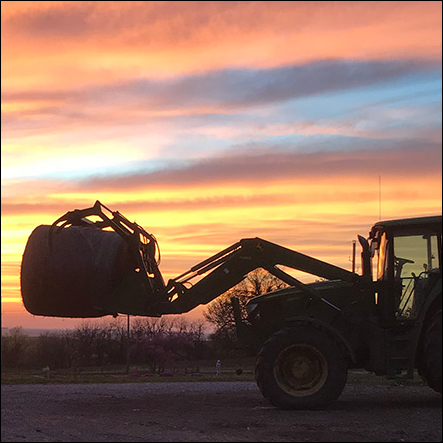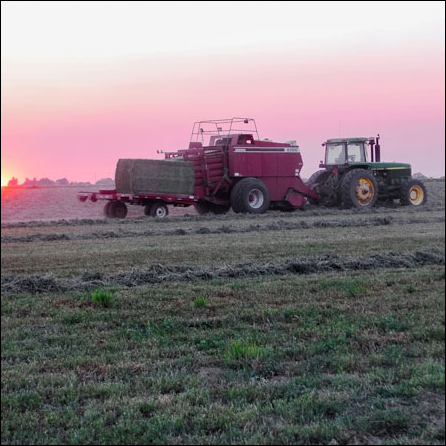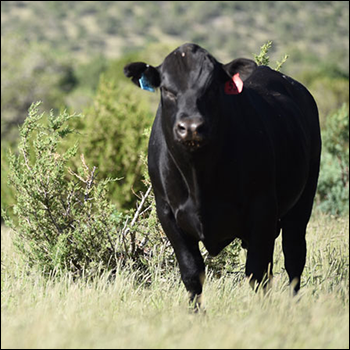In the Cattle Markets
Forage production, beef cows, stocking density and their implications for partial herd liquidation due to drought.
Approximately 654 million acres are used for livestock grazing, according to the Economic Research Service (ERS), or approximately 35% of the total land area in the continental United States. The total acres under grazing have fluctuated through time, ranging from a low of 583 million acres in the 1990s to a high of 654 million acres in the 2010s.
Fluctuations in grazed land have also varied across the United States’ diverse geography. For example, the Mountain region consists of approximately 55% of all grazed land; Southern Plains, 15%; and Northern Plains, 12%. All other regions have between 1% and 3% of the total grazed land.
Historically, beef cow herds have tended to follow the availability of cheap nutrient-rich forage, often in the form of grass and crop residue. For example, the Mountain region consists of about 15% of the total beef cow herd and generally relies on federally owned land that is leased back to producers during the grazing period. During winter, cattle are put on private pastures or fed harvested forages. The Southern and Northern Plains have 18% and 15% of the total beef cow herd, respectively, and have a large amount of private native grassland and expansive row crop production during grazing. Cattle are supplemented with harvested forages, protein concentrates and crop residues during winter.
All other regions have between 4% and 8% of the total beef cow herd and generally rely on improved pastures that can be utilized year-round with minor additional supplements. Historically, the share of beef cow herd by geographical region has not substantially varied, showing some consistency in the ability to use feed resources.
Availability of pasture to graze, or total beef cows within a region, does not tell us about how efficient each region is. The stocking rate (acres per beef cow) is one measure of efficiency where a lower ratio suggests greater efficiency (in other words, fewer acres required per cow).
While the Mountain, Southern Plains and Northern Plains regions have both the largest amount of grazed land and the greatest number of beef cows, these regions also have the highest stocking rate on average. The Mountain region required approximately 50 grazed acres per beef cow, by far the highest of any region. The Southern Plains requires 15 acres per beef cow and the Northern Plains requires 11 acres per beef cow. The most efficient regions, at least from the stocking rate measure, were the Northeast, Lake States and Appalachian regions. On average, these regions required 1.5 grazed acres per beef cow. As previously mentioned, these stocking rates are in part reflective of the climate, feed resources and pasture improvements.
So, what do grazed pasture, beef cow populations and stocking density tell us about the potential effects of beef cow herd liquidation due to drought? Areas with lower stocking rates are likely areas that are at more risk to adverse weather conditions since they rely upon either seasonal or harvested feed resources to sustain a beef cow herd.
Further, in the absence of seasonal forage, there are not large amounts of crop residues or protein concentrates from ethanol plants to supplement the lack of forage. The mid-May Drought Monitor map confirms that the Mountain region and parts of the Northern Plains region are currently the most affected by drought conditions. The USDA Pasture and Forage Conditions report confirm these findings, indicating nearly 50% of U.S. range and pasture was rated as either poor or very poor. As previously mentioned, there are regional differences in range and pasture ratings. One reason this number is so high is that more than 70% of the total grazed range and pasture is rated at a D1 level (moderate drought) or greater.
Moving into this forage production year, producers will have two options: 1) destock or 2) depopulate. Depopulation means selling cows, heifers, yearlings and calves to fit the available forage. Destocking means either moving cattle to newly obtained pasture (rented or purchased) or purchasing hay for the current herd size. With the U.S. beef cow herd peaking in 2019 and beginning its liquidation process, increasing drought pressure could only accelerate this liquidation process.
What strategy should producers who are wanting to maximize profits use, given drought has occurred at the trough of the cattle price cycle? Work by Wyoming ag economists modeled the producer profit-maximizing decision in a drought conditional on where the industry is in the cattle price cycle and length of drought (Bastian et al., 2008). They modeled three- and four-year drought conditions using a producer strategy for either partial herd liquidation and/or purchase of additional hay as a management strategy, given either a peak-to-peak or trough-to-trough cattle price cycle.
They found that in the short run, partial liquidation of cattle tended to provide better returns than purchasing feed to overcome constrained forage supplies. They also found that partial liquidation tended to be less risky and create potentially less financial stress than purchasing feed. Further, purchasing additional feed provided positive returns only when prices were stronger overall during a trough-to-trough cattle price cycle as compared to the peak-to-peak cattle price cycle scenario. Thus, given we are at the trough of the price cycle, risk-averse producers are more likely to partially liquidate their beef cow herd rather than to buy feed resources.
However, if producers believe that prices are likely to be stronger, on average, during the upcoming trough-to-trough cycle, they will buy feed resources. Given the increasing volatility in the cattle markets, I believe most producers are more likely to at least partially liquidate their beef cow herd than to buy feed resources. This of course assumes no indemnity payouts from Pasture, Range, and Forage Insurance (PRF). A producer who has already protected forage with PRF is more likely to buy additional feed resources than to partially liquidate their herd.
What this potential partial beef cow herd liquidation means for cull-cow and feeder-cattle prices will likely differ based on geographical region. If producers decide to liquidate, the cull-cow prices will come down mostly in the Mountain and Northern Plains region. Cull-cow prices are likely to be unaffected in other regions because beef cow markets are generally assumed to be regionally based on cow genetics rather than subject to market arbitrage.
Under a situation of worsening drought, more feeder cattle will enter feedlots earlier than expected, lowering feeder-cattle prices. With the influx of liquidated feeder cattle from the Mountain and Pacific regions, Northern and Southern Plains feedlots will be able to get feeder cattle cheaper there than from other regions. Thus, if drought conditions worsen in the Mountain and Pacific regions, feedlot demand for feeder cattle in the Southeast and Appalachian regions will likely decrease.
A drought scenario combined with elevated corn and soybean prices is a worst-case scenario. With elevated feed costs, feedlots would have further incentive to delay feeder-cattle placements, especially placements of lighter feeder cattle, since the cost of gain would be too high. This would put further downward pressure on feeder-cattle prices. Risk management in the form of USDA Risk Management Agency (RMA) Livestock Risk Protection (LRP) or CME futures and options can help mitigate some of these potential downward price movements, and likely merit a closer look by producers this production year.
Editor’s note: This article is adapted and reprinted with permission from the Livestock Marketing Information Center, available online at lmic.info. Elliott Dennis is assistant professor and livestock extension economist in the Department of Agricultural Economics at the University of Nebraska–Lincoln.




